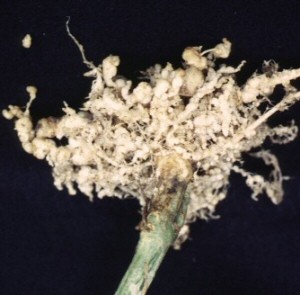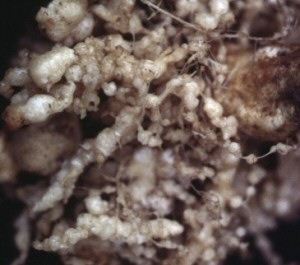Root-Knot on Tomatoes
 Causal Agent
Causal Agent
The nematode, Meloidogyne spp.
Hosts
Tomato and other crops
Symptoms
 The northern root-knot nematode produces small, discrete galls while the southern
and javanese root-knot nematodes produce large galls and massive root swellings. Infected
plants are stunted, appear yellow or pale green in color, and wilt easily, even when
soil moisture is adequate. Severe infestations can dramatically reduce yields and
eventually kill plants. Damage from root-knot nematode feeding may also increase the
incidence of other soilborne diseases such as Fusarium wilt and cause Fusarium wilt-resistant
varieties to become susceptible.
The northern root-knot nematode produces small, discrete galls while the southern
and javanese root-knot nematodes produce large galls and massive root swellings. Infected
plants are stunted, appear yellow or pale green in color, and wilt easily, even when
soil moisture is adequate. Severe infestations can dramatically reduce yields and
eventually kill plants. Damage from root-knot nematode feeding may also increase the
incidence of other soilborne diseases such as Fusarium wilt and cause Fusarium wilt-resistant
varieties to become susceptible.
Control
Management of root-knot should focus on sanitation measures for preventing contamination of soils, reducing populations below damaging levels where infestations already exist, and variety selection. Sanitation measures include planting nematode-free tomato transplants and avoiding the introduction of nematodes on any other type of transplant stock or with soil. This is difficult in reality because soil clinging to plant roots may contain nematodes without obvious plant symptoms. Equipment and boots should be washed free of soil before working clean ground when moving from areas suspected of harboring nematodes. Strategies for reducing nematode populations include starving nematodes by two-year crop rotations with resistant crops like corn, milo, and nematode-resistant soybean varieties; or with clean (weed-free) fallow. Soil solarization may be effective in some situations, but soil fumigation provides more consistent control of nematode populations (see OSU Extension Circular E-832). Soil fumigants are restricted use pesticides that can only be applied by certified applicators. Incorporation of cruciferous green manures such as cabbage, mustard, and rape into soil may also help reduce populations, particularly when combined with solarization. Many root-knot resistant tomato varieties are available. Please contact your local county extension office for current information.
